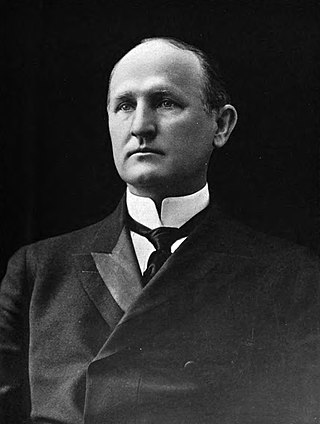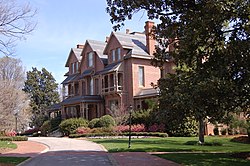
Joseph Melville Broughton Jr. was an American politician who served as the 60th governor of North Carolina from 1941 to 1945. He later briefly served as a United States Senator from January 3, 1949, until his death in office approximately two months later.

Charles Brantley Aycock was the 50th governor of the U.S. state of North Carolina from 1901 to 1905. After starting his career as a lawyer and teacher, he became active in the Democratic Party during the party's Solid South period, and made his reputation as a prominent segregationist.

Daniel Gould Fowle was the 46th governor of the U.S. state of North Carolina from 1889 until his death in 1891. He had served as a state superior court judge from 1865 to 1867.

Samuel Sloan was a Philadelphia-based architect and best-selling author of architecture books in the mid-19th century. He specialized in Italianate villas and country houses, churches, and institutional buildings. His most famous building—the octagonal mansion "Longwood" in Natchez, Mississippi—is unfinished; construction was abandoned during the American Civil War.

Historic Oakwood Cemetery was founded in 1869 in Raleigh, North Carolina, the state capital of North Carolina, near the North Carolina State Capitol in the city's Historic Oakwood neighborhood. Historic Oakwood Cemetery contains two special areas within its 102 acres (41 ha), the Confederate Cemetery, located on the original two and a half acres, and the Hebrew Cemetery, both given for that purpose by Henry Mordecai in 1867.

Broughton Hospital is a psychiatric hospital located in Morganton, North Carolina. It is administered by North Carolina Department of Health and Human Services Division of Mental Health, Developmental Disabilities and Substance Abuse Services.

The Hayes Barton Historic District is a neighborhood located northwest of downtown Raleigh, North Carolina, United States. Hayes Barton, an upper class neighborhood designed by landscape architect Earle Sumner Draper, contains 457 buildings on 1,750 acres (7.1 km2). The neighborhood design includes roads fitted to the contours of the land and features several public parks. The Hayes Barton neighborhood is roughly bounded by St. Mary's St., Fairview Rd., W. Roanoke Park Dr., Scales St. and Williamson Dr. In 2002, the district was listed on the National Register of Historic Places.
Adolphus Gustavus Bauer (1858–1898) was an architect in North Carolina. He worked with the more famous architect Samuel Sloan and helped him build the Executive Mansion in Raleigh.

The Hughes-Young House, most commonly known as Mistletoe Villa, is a historic house in Henderson, North Carolina. The house is often cited for its ornate Victorian detail and architectural elements. The first house on the site was built for William H. Hughes and completed in 1855. From 1883 to 1885 the house was significantly redesigned and overbuilt on the previous foundation for Ike J. Young, Civil War Colonel and four-term mayor of Henderson. The design of the current house is attributed to the famed architect Samuel Sloan but that fact has not been officially documented.
Richard Sharp Smith was an English-born American architect, noted for his association with George W. Vanderbilt's Biltmore Estate and Asheville, North Carolina. Smith worked for some of America's important architectural firms of the late 19th century—Richard Morris Hunt, Bradford Lee Gilbert, and Reid & Reid—before establishing his practice in Asheville. His most significant body of work is in Asheville and Western North Carolina, including dozens of buildings that are listed on the National Register of Historic Places or are contributing structures to National Register Historic Districts.

Alice Harper Willson Broughton was an American civic leader who served as the First Lady of North Carolina from 1941 to 1945 as the wife of Governor J. Melville Broughton. She and her husband were the first governor and first lady from Wake County to live in the North Carolina Executive Mansion. During World War II she was active in the war effort, promoting victory gardens across the state and establishing one at the governor's mansion, christening liberty ships including the SS Zebulon B. Vance and the SS Donald W. Bain, and donating rubber to the armed forces.

The Jolly-Broughton House is a historic Georgian Revival-style house in Raleigh, North Carolina. The house, completed in 1929, was the home of North Carolina Governor J. Melville Broughton and First Lady Alice Willson Broughton.

Jeanelle Coulter Moore was an American schoolteacher, patron of the arts, and civic leader who, as the wife of Governor Dan K. Moore, served as the First Lady of North Carolina from 1965 to 1969. She was the first wife of a governor in North Carolina to have a full-time secretary and maintain her own office in the North Carolina Executive Mansion, and she served as president of the Sir Walter Cabinet while her husband was in office. She was responsible for the creation of the Executive Mansion Fine Arts Committee within the North Carolina Department of Natural and Cultural Resources, which provides funding to restore and decorate the official residence, and established a chapel at the Raleigh Correctional Center for Women. Prior to her time as first lady, Moore served as a board member of the North Carolina Fund and of the North Carolina School of the Arts, having been appointed by Governor Terry Sanford. In 1980 she received the North Carolina Award for Public service.

Margaret Rose Sanford was an American civic leader, teacher, and philanthropist who, as the wife of Terry Sanford, served as First Lady of North Carolina from 1961 to 1965. Prior to entering public life, she worked as a teacher in North Carolina and Kentucky. As first lady, Sanford hosted the first annual North Carolina Symphony Ball in 1961, established a library of North Carolinian books at the North Carolina Executive Mansion, and planted a rose garden on the mansion's grounds. She was the first governor's wife to decorate the Governor's Western Residence in Asheville. Sanford sent her children to the first racially integrated public elementary school in Raleigh, North Carolina, while the family lived in the executive mansion. She served on the board of the Methodist Home for Children, the North Carolina School of the Arts, the Stagville Plantation Restoration Board, and East Carolina University. She was also a member of the Education Commission of the States and the Defense Department Advisory Committee on Women in the Services. While Sanford's husband served as president of Duke University, she was appointed by Governor Jim Hunt to serve on a delegation of university faculty and administrators to China in 1975.

Margaret Elizabeth Hoey was an American civic leader and political hostess who served as the First Lady of North Carolina from 1937 to 1941. She was part of the "Shelby Dynasty" and is the only North Carolinian first lady to be the wife of one governor, Clyde R. Hoey, and the sister of another governor, Oliver Max Gardner. While serving as first lady, Hoey focused on issues related to women's roles and children's welfare, advocated for highway beautification across the state, and established a green house for exotic plants at the state penitentiary.

Helen Whitaker Fowle Knight was an American political hostess. When her widowed father, Daniel Gould Fowle, became Governor of North Carolina in 1889, she served as the state's First Lady. She was the first North Carolinian first lady to live in the North Carolina Executive Mansion.

Cornelia Deaderick Glenn was an American society hostess and temperance activist who, as the wife of Robert Broadnax Glenn, served as First Lady of North Carolina from 1905 to 1909. She was involved in the temperance movement and avidly supported her husband's 1908 Prohibition campaign that banned liquor statewide. A devout Presbyterian, she was the founder of one of Winston-Salem's first benevolent societies.

Cora Lily Woodard Aycock was an American political hostess, farmer, and railway executive. As the second wife of Governor Charles Brantley Aycock, she served as First Lady of North Carolina from 1901 to 1905. While her husband was an outspoken white supremacist and segregationist, she was known to be rather apolitical but staunchly supported her husband's educational reforms for public schools. Aycock spent her time as first lady entertaining guests at small gatherings at the North Carolina Executive Mansion, raising her seven children and two surviving stepchildren, and instructing her children in music. Aycock was the first North Carolinian first lady to give birth at the executive mansion.

Fanny Neal Yarborough Bickett was an American social worker, public official, lawyer, and lobbyist. She served as the First Lady of North Carolina from 1917 to 1921, as the wife of Governor Thomas W. Bickett, and used her influence in his administration to enact social reforms and support women's suffrage. During World War I, she maintained a victory garden at the North Carolina Executive Mansion and promoted home gardens to support the war effort. Bickett was the commandant of the Southeastern District of the U.S. Training Corps and visited American troops in France as a representative of the YMCA.





















